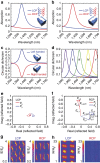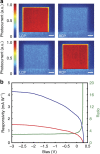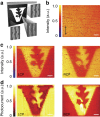Circularly polarized light detection with hot electrons in chiral plasmonic metamaterials
- PMID: 26391292
- PMCID: PMC4595755
- DOI: 10.1038/ncomms9379
Circularly polarized light detection with hot electrons in chiral plasmonic metamaterials
Abstract
Circularly polarized light is utilized in various optical techniques and devices. However, using conventional optical systems to generate, analyse and detect circularly polarized light involves multiple optical elements, making it challenging to realize miniature and integrated devices. While a number of ultracompact optical elements for manipulating circularly polarized light have recently been demonstrated, the development of an efficient and highly selective circularly polarized light photodetector remains challenging. Here we report on an ultracompact circularly polarized light detector that combines large engineered chirality, realized using chiral plasmonic metamaterials, with hot electron injection. We demonstrate the detector's ability to distinguish between left and right hand circularly polarized light without the use of additional optical elements. Implementation of this photodetector could lead to enhanced security in fibre and free-space communication, as well as emission, imaging and sensing applications for circularly polarized light using a highly integrated photonic platform.
Figures





References
-
- Sherson J. F. et al. Quantum teleportation between light and matter. Nature 443, 557–560 (2006). - PubMed
-
- Wagenknecht C. et al. Experimental demonstration of a heralded entanglement source. Nat. Photon. 4, 549–552 (2010).
-
- Togan E. et al. Quantum entanglement between an optical photon and a solid-state spin qubit. Nature 466, 730–734 (2010). - PubMed
-
- Farshchi R., Ramsteiner M., Herfort J., Tahraoui A. & Grahn H. T. Optical communication of spin information between light emitting diodes. Appl. Phys. Lett. 98, 162508 (2011).
Publication types
LinkOut - more resources
Full Text Sources
Other Literature Sources

